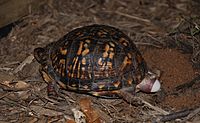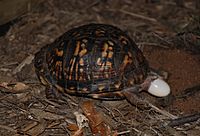North American box turtle facts for kids
Quick facts for kids North American box turtle |
|
|---|---|
 |
|
| Florida box turtle, Terrapene carolina bauri | |
| Scientific classification |
|
| Kingdom: | Animalia |
| Phylum: | Chordata |
| Class: | Reptilia |
| Order: | Testudines |
| Suborder: | Cryptodira |
| Family: | Emydidae |
| Subfamily: | Emydinae |
| Genus: | Terrapene Merrem, 1820 |
| Type species | |
| Terrapene carolina (Linnaeus, 1758)
|
|
| Species | |
|
Terrapene carolina |
|
| Synonyms | |
|
Cistuda Fleming, 1822 |
|
North American box turtles are cool turtles that belong to the group called Terrapene. Even though they look a bit like tortoises and live on land, they are actually part of the American pond turtle family, called Emydidae. There are seven different species of box turtles, with 12 types in total. They are famous for their tall, rounded shell that has a special hinge at the bottom. This hinge lets them pull their head and legs inside and close up their shell super tight. It's like having their own portable fort to protect themselves from animals that might want to eat them!
Contents
Types of Box Turtles
The name Terrapene was first used in 1820 by Blasius Merrem. He used it for turtles that could move parts of their bottom shell (called a sternum) on their own. Some turtles from Asia were once thought to be in this group, but now we know they are different. Currently, there are six main species of North American box turtles, and 12 different kinds (called taxa):
- Common box turtle, Terrapene carolina (Linnaeus, 1758) (This is the main type!)
- Florida box turtle, Terrapene carolina bauri Taylor, 1895
- Eastern box turtle, Terrapene carolina carolina (Linnaeus, 1758)
- Gulf Coast box turtle, Terrapene carolina major (Agassiz, 1857)
- Terrapene carolina putnami O.P. Hay, 1906 (This one is extinct, meaning it no longer exists.)
- Three-toed box turtle, Terrapene triunguis (Agassiz, 1857)
- Coahuilan box turtle, Terrapene coahuila Schmidt & Owens, 1944
- Mexican box turtle, Terrapene mexicana (Gray, 1849)
- Spotted box turtle, Terrapene nelsoni Stejneger, 1925
- Northern spotted box turtle, Terrapene nelsoni klauberi Bogert, 1943
- Southern spotted box turtle, Terrapene nelsoni nelsoni Stejneger, 1925
- Western box turtle, Terrapene ornata, (Agassiz, 1857)
- Ornate box turtle, Terrapene ornata ornata (Agassiz, 1857)
- Desert box turtle, Terrapene ornata luteola H.M. Smith & Ramsey, 1952
- Yucatán box turtle, Terrapene yucatana (Boulenger, 1895)
Life Cycle and Behavior
Box turtles can live a very long time! Once they become adults, their chance of dying doesn't really go up with age. Adult box turtles usually live for about 50 years, but many can live for over 100 years. It's hard to tell a wild box turtle's exact age by counting the rings on its shell, because their growth depends on things like food, water, and if they get sick.
Reproduction and Eggs
Box turtle eggs are soft and oval-shaped. They are usually about 2–4 cm long and weigh 5-11 grams. A female box turtle typically lays 1 to 7 eggs at a time. In warmer areas or when kept as pets, box turtles might lay eggs more than once a year. Turtles in northern areas tend to lay more eggs in each group.
Predators
Young box turtles are most at risk because their shells are not as strong. While an adult box turtle's shell is very tough, they can still be surprised by predators. Common predators include mammals like minks, skunks, raccoons, and dogs. Birds like crows and ravens, and snakes like racers can also hunt box turtles.
What Do They Eat?
North American box turtles are omnivores, which means they eat both plants and animals. They will "basically eat anything they can catch"! Their diet mostly includes small creatures without backbones, like insects, earthworms, and millipedes. They also eat a lot of plants, fruits (like berries and cactus fruits), and snails. Some people used to think young box turtles ate mostly meat and adults ate mostly plants, but scientists haven't found proof for this idea.
Where Box Turtles Live
Box turtles are native to North America. The most common type, the common box turtle, lives in many parts of the United States and Mexico. The western box turtle lives in the south-central and southwestern U.S. and nearby Mexico. The spotted box turtle is only found in northwestern Mexico. The Coahuilan box turtle lives in a very specific area in Mexico called the Cuatro Ciénegas Basin, which is a marshy area with lots of water and cacti.
Their Homes
Box turtles live in many different kinds of places, and their habitat can change depending on the day, season, or even the specific type of turtle. They are often found in woodlands (forests with a good amount of moisture). The western box turtle is the only species that regularly lives in grasslands. Its desert cousin also lives in dry areas that get most of their rain in summer.
When winter comes, box turtles often move deeper into the woods. They dig a special underground room to stay safe and warm during hibernation. Ornate box turtles can dig chambers up to 50 centimeters deep, while eastern box turtles hibernate about 10 centimeters deep. They might go back to the same hibernation spot each year, sometimes up to half a kilometer from their summer home. In warmer southern places, some box turtles, like the Coahuilan box turtle, stay active all year long. Other box turtles in hot areas are more active during the wet seasons.
Box Turtles and People
Protecting Box Turtles
The protection status of box turtles varies by species. The Terrapene coahuila (Coahuilan box turtle) is listed as endangered. This is because its living area has shrunk by 40% in the last 40-50 years, and its population has dropped from over 10,000 to about 2,500 in 2002. The common box turtle (Terrapene carolina) is considered vulnerable, while the western box turtle (Terrapene ornata) is listed as near threatened. We don't have enough information to classify Terrapene nelsoni.
The Eastern box turtle has faced problems due to human activities and diseases. Scientists have found bacterial infections that have caused many deaths. A virus called Ranavirus can also harm them. Studying these diseases is important to help protect box turtle populations. Some conservation groups even train special sniffer dogs to find and track box turtles to help with protection efforts!
Box Turtles as Pets
Most turtle experts suggest that box turtles are not the best pets for young children. Box turtles can get stressed easily if they are handled too much. They also need more care than many people realize. If a box turtle is moved far from where it grew up, it might wander around trying to find its original home until it dies. The three-toed box turtle is sometimes thought to be a better pet because it's quite tough and seems to handle new places better.
It's important to protect pet box turtles from dogs and cats, as these household pets can easily injure them. Box turtles need an outdoor space (though they can have indoor enclosures when needed), plenty of light, and a variety of foods. Without these, they might not grow properly and could get sick easily.
If you are thinking about getting a box turtle, it's best to buy one that was born and raised by people (if allowed where you live). This helps protect wild box turtle populations. Studies have shown that many box turtles are taken from the wild to be sold as pets, sometimes thousands at a time. Sadly, many of these wild-caught turtles are kept in poor conditions and can get sick or even die before they are sold.
Some states in the U.S. do not allow people to collect wild turtles, and many require a special permit to keep them. Breeding box turtles is also not allowed in some places, to prevent harm to wild populations. Taking box turtles from the wild can really hurt their numbers because they don't have many babies.
State Reptiles
Box turtles are the official state reptile in four U.S. states! North Carolina and Tennessee chose the eastern box turtle. Missouri picked the three-toed box turtle. Kansas honors the ornate box turtle.
In Pennsylvania and Virginia, there have been attempts to make the eastern box turtle their state reptile, but these efforts haven't succeeded yet.
Images for kids
-
Florida box turtle in southeast Georgia
See also
 In Spanish: Terrapene para niños
In Spanish: Terrapene para niños
- Asian box turtle











